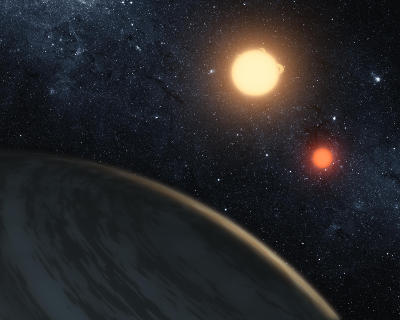Using AI to control energy for indoor agriculture
30 September 2024
Published online 1 September 2015
The orbits of planets in a binary star system can be severely disrupted by the gravity of their companion star.

© NASA/JPL-Caltech/T. Pyle
Now, Jihad Touma at the American University of Beirut in Lebanon and Seshadri Sridhar at the Raman Research Institute in Bangalore, India, have described a new mechanism by which a binary companion star could disrupt the orbits of planets, to the extent that planets may even escape the system entirely.
The dramatic situation arises when orbital precession in the planetary system – the rotation of the elliptical orbits – changes to match the orbital period of the binary companion star. This ‘orbital resonance’ could explain why multiplanet systems are rarely found around binary stars.
Touma and Sridhar wondered about the possibility of orbital resonance in binaries during a walk around the Beirut campus. “When we ran the numbers for some real multiplanet systems in binaries, called 55 Cancri and Upsilon Andromedae, we found that the periods of planetary precession occurred remarkably close to the binary orbital period,” says Touma.
To investigate, the researchers performed simulations of two planets orbiting a star similar to our Sun, with a distant binary companion star of the same size.
They allowed the outer planet to migrate outwards – a realistic potential consequence of collisions with the cloud of debris around the star. This changed the planet’s orbit until it resonated with the binary companion. At this point, the effect of the companion star was greatly amplified, such that the planet’s orbit became more eccentric then inclined.
The researchers named this process the Laplace-Lagrange Evection Resonance (LLER), after the founders of planetary dynamics. They showed that LLER was a plausible possibility for many real multiplanet systems listed in the Open Exoplanet Catalogue.
Touma and Sridhar simulated the science-fiction scenario of a companion star appearing near our own Sun and found it was very likely that under the scenario Saturn would be captured in LLER, greatly disrupting the outer solar system.
“Anyone concerned with the formation and evolution of multiplanet systems will need to allow for the possibility that LLER could either affect the disks out of which planets form, or the architecture of the planetary systems that result,” says Touma.
doi:10.1038/nmiddleeast.2015.157
Touma, J.R. et al. The disruption of multiplanet systems through resonance with a binary orbit. Nature http://dx.doi.org/10.1038/nature14873 (2015).
Stay connected: